Labral Tear of the Shoulder
Updated:
(Also known as a Shoulder Labrum Tear, SLAP Lesion, SLAP Tear, Glenoid Labral Tear)
What is a labral tear of the shoulder?
A labral tear of the shoulder is a condition characterized by tearing of the cartilage tissue within the shoulder joint known as the labrum.
The shoulder joint is a ball and socket joint – the ball arising from the top of the humerus (upper arm bone) and the scapula (shoulder blade) giving rise to the socket. The relative depth of the socket of the shoulder joint is increased by cartilage, known as the labrum, which attaches to the rim of the shoulder joint (figures 1 & 2). This cartilage helps improve the congruency of the bones (i.e. improved ‘fit’) and, therefore, aids shoulder stability.
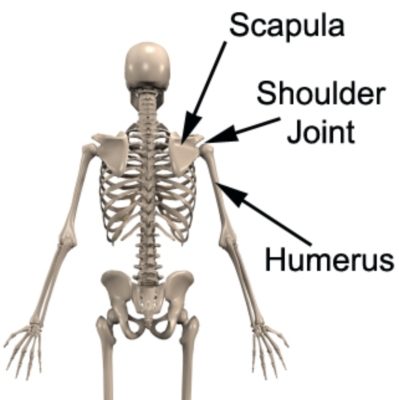
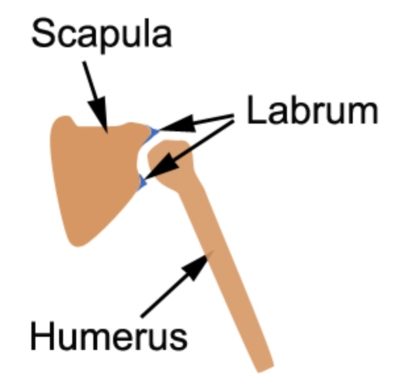
The labrum also aids shock absorption, cushioning the impact of the humerus on the scapula during upper limb weight bearing. Normally the surface of the labrum is very smooth allowing easy movement of the humerus on the scapula. Occasionally, however, the labrum can be torn or damaged so that the surface is no longer smooth. When this occurs, the condition is known as a labral tear of the shoulder.
Causes of a labral tear of the shoulder
A labral tear of the shoulder typically occurs suddenly due to a high force going through the labrum beyond what it can withstand. This may be due to heavy or awkward lifting, a fall onto an outstretched hand, point of the shoulder or an elbow, during heavy pushing or pulling, or a forceful throw. A labral tear also commonly occurs in association with a dislocated shoulder.
Occasionally, a labral tear of the shoulder may develop over time due to gradual wear and tear associated with overuse. This may cause gradual degeneration and weakening of the labrum predisposing it to further injury. These labral tears of the shoulder typically occur due to repetitive or prolonged weight bearing activities (including lying on the affected shoulder), lifting or overhead activities and are most common in the older population. In athletes, labral tears are commonly seen in throwing sports (such as cricket or baseball), swimming, racquet sports (such as tennis) or weight lifting.
Signs and symptoms of a labral tear of the shoulder
Patients with a labral tear of the shoulder may report that, at the time of injury, they heard an audible sound, experienced a tearing sensation or felt the shoulder joint move out of place.
Pain is usually felt in the front, back or side of the shoulder and may radiate into the upper arm (often the biceps), or less commonly, the upper back or neck. Symptoms may increase with certain, often quite specific, movements of the upper limb, such as arm elevation and lifting (especially overhead), weight bearing activities through the upper limb (such as push-ups or dips), or pushing and pulling movements of the shoulder (particularly when combined with rotation). Patients may also experience pain when lying on the affected shoulder, or, during certain sporting activities, such as throwing, serving in tennis or butterfly stroke in swimming.
Patients with a minor labral tear of the shoulder may experience little or no immediate symptoms. In these cases, symptoms may develop gradually over time, typically with an increase in use of the shoulder and arm. Sometimes patients may be able to continue sport or activity only to have an increase in pain upon resting later (particularly that night or the following morning). In more severe cases, there may be significant restriction in shoulder range of movement and severe pain preventing further activity. Intermittent locking, clicking sensations, episodes of giving way or sudden weakness of the shoulder, may also be present.
Diagnosis of a labral tear of the shoulder
A thorough subjective and objective examination from a physiotherapist is important in identifying the likelihood of a labral tear of the shoulder. MRI investigation is often used to confirm diagnosis, assess the severity of injury and (along with other investigations, such as an X-ray and ultrasound) exclude the presence of other injuries in the shoulder. In rare cases, where an MRI has proven inconclusive, an investigative arthroscope may be performed to assist diagnosis.
Treatment for a labral tear of the shoulder

Members Only ContentBecome a PhysioAdvisor Member to gain full access to this exclusive content. For more details see Become a Member. Already a member? Login Now
Surgery for a labral tear of the shoulder
Generally, most patients with a significant labral tear of the shoulder will require surgery to ensure an optimal outcome. Surgery for labral tears is generally minimally invasive, involving arthroscopy (‘key hole surgery’). During this procedure, the surgeon either removes or repairs the torn tissue enabling the shoulder joint to move freely once again. In cases of a large labral tear with bony damage, surgical fixation of the bony fragment and labrum may be indicated. The treating physiotherapist and doctor will refer to a specialist if surgery may be indicated. Physiotherapy and rehabilitation is then required following surgery to ensure an optimal outcome and enable a safe return to sport or activity.
Prognosis of a labral tear of the shoulder
Those patients with a minor labral tear of the shoulder that responds well to conservative management can usually return to sport or activity in approximately 2 – 8 weeks.
For minor tears that are managed surgically, patients can sometimes return to sport or activity within 4 – 12 weeks, although most patients (especially when the tear is moderate to severe) will require a significantly longer rehabilitation period (usually between 3-12 months).
It is important that patients with a labral tear of the shoulder are managed appropriately, as inappropriate treatment may lead to the development of early shoulder osteoarthritis.
Contributing factors to the development of a labral tear of the shoulder
There are several factors which can predispose patients to developing a labral tear of the shoulder. These need to be assessed and corrected with direction from a physiotherapist. Some of these factors include:
- abnormal biomechanics (eg. poor throwing technique or stroke technique with swimming)
- muscle tightness or imbalances
- neck, upper back and shoulder stiffness
- muscle weakness (especially the scapular stabilizers and rotator cuff muscles)
- poor posture
- excessive or inappropriate training or activity
- inadequate rest periods from training or activity
- inadequate warm-up
- poor core stability
Physiotherapy for a labral tear of the shoulder

Members Only ContentBecome a PhysioAdvisor Member to gain full access to this exclusive content. For more details see Become a Member. Already a member? Login Now
Other intervention for a labral tear of the shoulder
Despite appropriate physiotherapy management, some patients with a labral tear of the shoulder fail to improve adequately either conservatively or following surgery. When this occurs the treating physiotherapist or doctor can advise on the best course of management. This may include further investigations such as X-rays, MRI or CT scans, pharmaceutical intervention, corticosteroid injection, hydrodilatation, or further surgery.
Exercises for a labral tear of the shoulder
The following exercises are commonly prescribed to patients with a labral tear of the shoulder. You should discuss the suitability of these exercises with your physiotherapist prior to beginning them. Generally, they should be performed 3 times daily and only provided they do not cause or increase symptoms.
Your physiotherapist can advise when it is appropriate to begin the initial exercises and eventually progress to the intermediate, advanced and other exercises. As a general rule, addition of exercises or progression to more advanced exercises should take place provided there is no increase in symptoms.
Initial Exercises
Shoulder Blade Squeezes
Begin sitting or standing tall with your back straight (figure 3). Your chin should be tucked in slightly and your shoulder blades should be back slightly. Slowly squeeze your shoulder blades together as hard and far as possible provided it does not cause or increase symptoms. Hold for 5 seconds and repeat 10 times.

Pendular Exercises
Begin this exercise by leaning forwards with the forearm of your uninjured arm supported on a table or bench (figure 4). Keeping your back straight and your shoulder relaxed, gently swing your affected arm forwards and backwards as far as you can go without pain and provided you feel either nothing, or, no more than a mild to moderate stretch. Repeat 10 times provided the exercise does not cause or increase symptoms. Repeat the exercise swinging your arm side to side provided it is pain free.
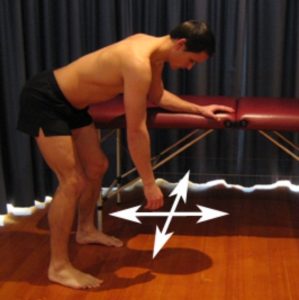
Pendular Circles
Begin this exercise by leaning forwards with the forearm of your uninjured arm supported on a table or bench (figure 5). Keeping your back straight and your shoulder relaxed, gently swing your affected arm in circles clockwise as far as you can go without pain and provided you feel either nothing, or, no more than a mild to moderate stretch. Repeat the exercise swinging your arm counter clockwise Repeat 10 times in each direction provided there is no increase in symptoms.
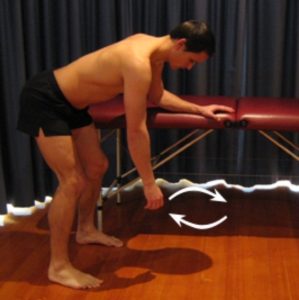
Intermediate Exercises

Members Only ContentBecome a PhysioAdvisor Member to gain full access to this exclusive content. For more details see Become a Member. Already a member? Login Now
Advanced Exercises

Members Only ContentBecome a PhysioAdvisor Member to gain full access to this exclusive content. For more details see Become a Member. Already a member? Login Now
Other Exercises

Members Only ContentBecome a PhysioAdvisor Member to gain full access to this exclusive content. For more details see Become a Member. Already a member? Login Now
Rehabilitation protocol for a labral tear of the shoulder

Members Only ContentBecome a PhysioAdvisor Member to gain full access to this exclusive content. For more details see Become a Member. Already a member? Login Now
 Physiotherapy products for a labral tear of the shoulder
Physiotherapy products for a labral tear of the shoulder
Some of the most commonly recommended products by physiotherapists to hasten healing and speed recovery in patients with a labral tear of the shoulder include:
-
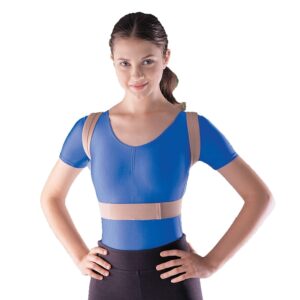 OPPO – Posture Aid / Clavicle Brace (OPP2075)
OPPO – Posture Aid / Clavicle Brace (OPP2075) -
 AllCare Band
AllCare Band -
 Oppo Humerus Brace (OPP4072)
Oppo Humerus Brace (OPP4072) -
 Premium Strapping Tape 38mm (Victor)
Premium Strapping Tape 38mm (Victor) -
 AllCare Pro-TENS Machine
AllCare Pro-TENS Machine -
 AllCare Tubing
AllCare Tubing -
 AllCare Spikey Massage Ball
AllCare Spikey Massage Ball -
 AllCare Instant Cold Pack (15 x 25cm)
AllCare Instant Cold Pack (15 x 25cm) -
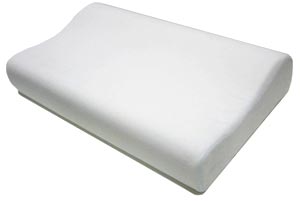 Dentons Impressions Classic Memory Foam Therapeutic Pillow
Dentons Impressions Classic Memory Foam Therapeutic Pillow -
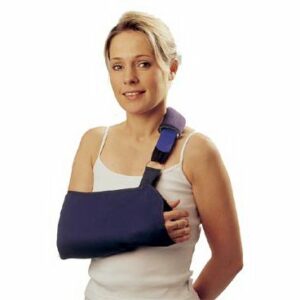 Actimove Arm Sling (Mitella)
Actimove Arm Sling (Mitella)
To purchase physiotherapy products for a labral tear of the shoulder click on one of the above links or visit the PhysioAdvisor Shop.
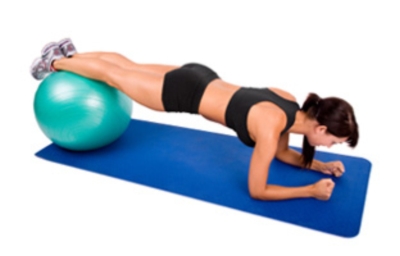 Other Exercises
Other Exercises
- Shoulder Stretches
- Shoulder Strengthening Exercises
- Scapula Stability Exercises.
- Rotator Cuff Strengthening Exercises.
- Neck Stretches
- Postural Exercises
- Arm Strengthening Exercises.
- Upper Body Machine Weights.
- Cable Exercises (Back & Biceps)
- Cable Exercises (Chest, Shoulders & Triceps).
- Free Weights (Back & Biceps).
- Free Weights (Chest, Shoulders & Triceps).
 Recommended Reading
Recommended Reading
- Shoulder Taping
- Postural Taping.
- Posture.
- Ice or Heat.
- The R.I.C.E. Regime.
- Injury Prevention.
- Investigations
- Understanding Pain
- Returning to Sport.
- Warming up and Cooling Down
- Shoulder Diagnosis Guide.
 Find a Physio for a labral tear of the shoulder
Find a Physio for a labral tear of the shoulder
Find a physiotherapist in your local area who can treat a labral tear of the shoulder.
Become a PhysioAdvisor Member

Link to this Page
If you would like to link to this article on your website, simply copy the code below and add it to your page:
<a href="https://physioadvisor.com.au/injuries/shoulder/labral-tear-of-the-shoulder”>Labral Tear of the Shoulder – PhysioAdvisor.com</a><br/>A labral tear of the shoulder is a condition characterised by tearing of the cartilage tissue within the shoulder joint known as the labrum.
Return to the top of Labral Tear of the Shoulder.

